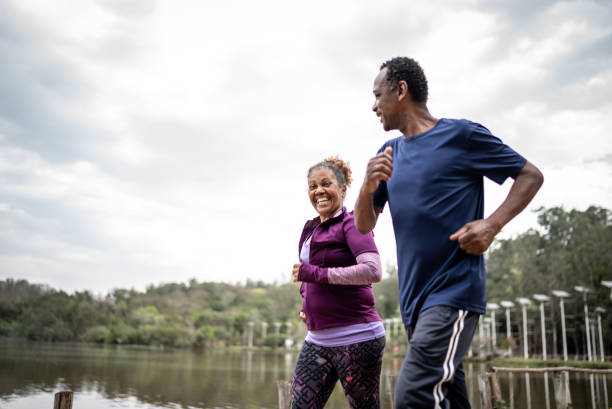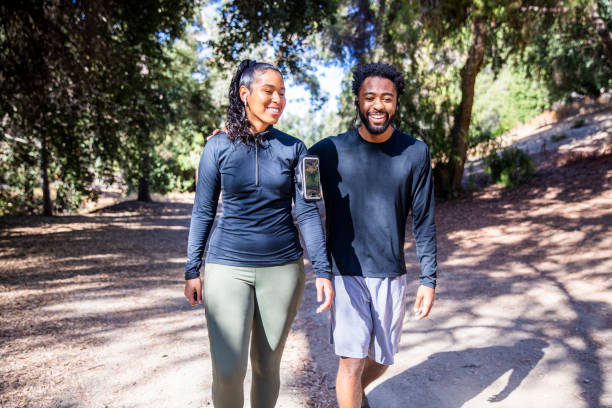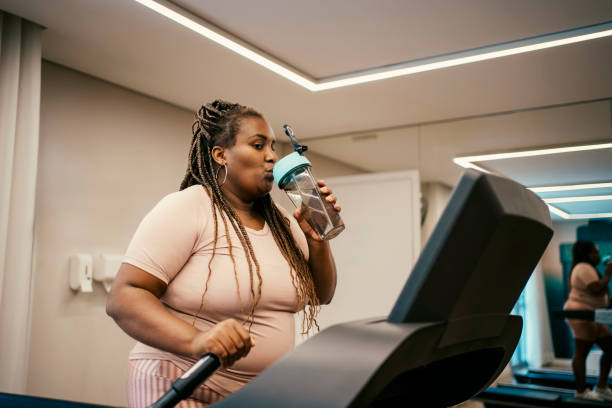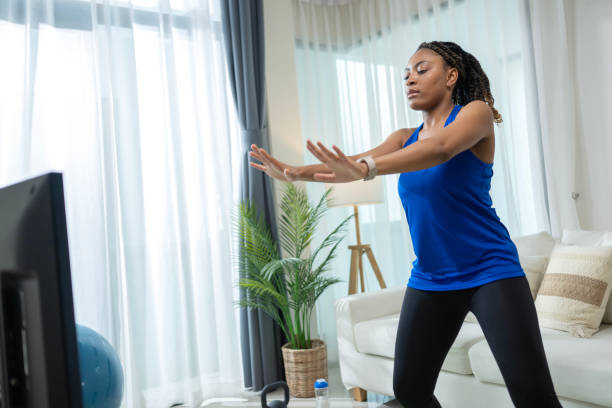(BlackFitness101.com) Aging is a natural part of life, and as we grow older, our bodies undergo numerous changes that can affect our overall health and fitness levels. While staying active is crucial at every age, the way we approach our fitness routine must evolve as we age. What worked for you in your 20s or 30s may not be as effective—or safe—in your 50s or 60s. Understanding how aging impacts your body and how to adjust your fitness routine accordingly is essential for maintaining health, vitality, and quality of life. In this article, I will discuss five key ways that aging can affect your fitness routine and offer practical advice on how to adapt to these changes.

1. Decreased Muscle Mass and Strength
One of the most significant changes that occur with aging is the gradual loss of muscle mass, a condition known as sarcopenia. Starting as early as your 30s, you begin to lose muscle mass at a rate of about 3% to 5% per decade. By the time you reach your 60s, this rate accelerates, making it more challenging to maintain the same level of strength and endurance you had in your younger years.
How It Affects Your Fitness Routine:
- Strength Training Becomes Essential: As muscle mass decreases, so does your overall strength. This reduction in strength can make it more difficult to perform exercises that were once easy, such as lifting weights or even carrying groceries. To combat this, incorporating strength training into your fitness routine becomes increasingly important. Resistance exercises, such as weightlifting, bodyweight exercises, and resistance band workouts, can help you preserve and build muscle mass.
- Recovery Time Increases: With age, your body’s ability to recover from workouts slows down. This means you might need more time between strength training sessions to allow your muscles to repair and grow. Overtraining can lead to injuries, so it’s crucial to listen to your body and give it the rest it needs.
Adjustments to Make:
- Focus on Functional Movements: Incorporate exercises that mimic everyday activities, such as squats, lunges, and deadlifts. These functional movements help maintain your ability to perform daily tasks independently.
- Increase Protein Intake: As you age, your body requires more protein to maintain muscle mass. Ensure your diet includes adequate protein from sources like lean meats, fish, eggs, dairy, and plant-based options such as beans and legumes.
2. Reduced Bone Density
As we age, our bones naturally become less dense and more brittle, a condition known as osteoporosis. This process can begin as early as your 30s and becomes more pronounced in women after menopause due to a decrease in estrogen levels. Reduced bone density increases the risk of fractures and injuries, particularly in weight-bearing joints like the hips, knees, and spine.
How It Affects Your Fitness Routine:
- Weight-Bearing Exercises Are Key: To counteract the loss of bone density, weight-bearing exercises are crucial. These exercises force you to work against gravity and include activities like walking, jogging, hiking, and resistance training. Engaging in these types of exercises can help stimulate bone growth and maintain bone density.
- Balance and Coordination May Decline: With reduced bone density comes an increased risk of falls, which can lead to fractures. Aging also affects the inner ear and nervous system, leading to decreased balance and coordination. Incorporating balance exercises into your routine can help reduce the risk of falls and improve overall stability.
Adjustments to Make:
- Incorporate Balance Training: Activities such as yoga, tai chi, or simple balance exercises (like standing on one leg) can enhance your balance and coordination. This not only helps prevent falls but also improves your overall mobility.
- Consider Low-Impact Activities: While weight-bearing exercises are important, you should also include low-impact activities that are easier on the joints, such as swimming or cycling. These activities can provide cardiovascular benefits without putting excessive strain on your bones and joints.
3. Changes in Metabolism
As you age, your metabolism naturally slows down, which can lead to weight gain if you don’t adjust your diet and exercise routine. A slower metabolism means your body burns fewer calories at rest, making it easier to gain weight even if your eating habits haven’t changed. This change is often compounded by a decrease in muscle mass, as muscle tissue burns more calories than fat tissue.
How It Affects Your Fitness Routine:
- Increased Need for Cardiovascular Exercise: To combat a slower metabolism, incorporating more cardiovascular exercise into your routine is essential. Cardio exercises, such as brisk walking, running, cycling, and swimming, can help boost your metabolism and burn calories.
- Diet Becomes More Important: With a slower metabolism, it becomes more important to monitor your diet. Consuming nutrient-dense foods and reducing your intake of empty calories (such as sugary snacks and processed foods) can help you manage your weight more effectively.
Adjustments to Make:
- Increase Cardio Frequency: If you’ve been focusing primarily on strength training, consider increasing the frequency and intensity of your cardiovascular workouts. Aim for at least 150 minutes of moderate-intensity cardio each week, as recommended by the American Heart Association.
- Monitor Your Caloric Intake: Keep an eye on portion sizes and overall caloric intake. You may need to reduce your calorie consumption to match your body’s decreased energy expenditure. Focus on whole, unprocessed foods that provide essential nutrients without excess calories.
4. Joint Stiffness and Reduced Flexibility
Joint stiffness and reduced flexibility are common complaints as we age. These issues can be attributed to several factors, including the natural wear and tear of cartilage, decreased production of synovial fluid (which lubricates the joints), and the shortening of tendons and ligaments. As a result, you may experience reduced range of motion, making certain exercises and activities more challenging or even painful.
How It Affects Your Fitness Routine:
- Flexibility and Mobility Training Becomes Crucial: To maintain joint health and prevent stiffness, incorporating flexibility and mobility exercises into your routine is essential. Stretching, yoga, and foam rolling can help improve your range of motion and reduce the risk of injury.
- Modify High-Impact Activities: High-impact exercises, such as running or jumping, can be tough on aging joints, especially if you have a history of joint issues or arthritis. You may need to modify these activities or replace them with lower-impact alternatives to avoid exacerbating joint pain.
Adjustments to Make:
- Incorporate Dynamic and Static Stretching: Start each workout with dynamic stretches (such as leg swings or arm circles) to warm up your muscles and joints. End your workout with static stretches, holding each stretch for 20-30 seconds to improve flexibility.
- Use Joint-Friendly Exercises: Consider replacing high-impact exercises with low-impact alternatives, such as swimming, cycling, or using an elliptical machine. These exercises provide cardiovascular benefits without placing excessive stress on your joints.
5. Changes in Cardiovascular Health
Cardiovascular health naturally declines with age, as the heart and blood vessels become less efficient. The walls of the arteries may thicken and stiffen, leading to higher blood pressure, while the heart muscle itself may weaken, reducing the efficiency of blood circulation. These changes can increase the risk of cardiovascular diseases, such as heart disease and stroke.
How It Affects Your Fitness Routine:
- Need for Consistent Cardiovascular Exercise: Maintaining heart health is crucial as you age, making regular cardiovascular exercise an essential part of your fitness routine. Engaging in activities that elevate your heart rate, such as walking, swimming, or cycling, can help improve cardiovascular fitness and reduce the risk of heart-related conditions.
- Monitoring Intensity Levels: As your cardiovascular system changes, you may find that high-intensity workouts become more challenging. It’s important to monitor your heart rate during exercise and adjust the intensity of your workouts to match your fitness level. Overexertion can lead to heart strain or other cardiovascular issues, so it’s essential to find a balance that keeps you active without pushing your body too hard.
Adjustments to Make:
- Incorporate Interval Training: Interval training, which alternates between periods of high and low intensity, can be an effective way to improve cardiovascular fitness without overloading your heart. For example, you might alternate between brisk walking and jogging, or between cycling at a steady pace and doing short sprints.
- Regular Health Check-Ups: As you age, it’s important to have regular check-ups with your healthcare provider to monitor your cardiovascular health. Your doctor can provide personalized advice on how to adjust your fitness routine based on your current health status.
Aging is an inevitable process, but it doesn’t have to mean giving up on fitness. By understanding how aging affects your body and making appropriate adjustments to your fitness routine, you can continue to lead an active, healthy, and fulfilling life. The key is to listen to your body, focus on maintaining muscle mass, bone density, and cardiovascular health, and adapt your exercise regimen to meet your changing needs. With the right approach, you can enjoy the benefits of physical activity well into your golden years, ensuring that you remain strong, flexible, and full of vitality.
Staff Writer; Janet Banks
Questions? Feel free to email me at; JBanks@BlackFitness101.com.












Leave a Reply